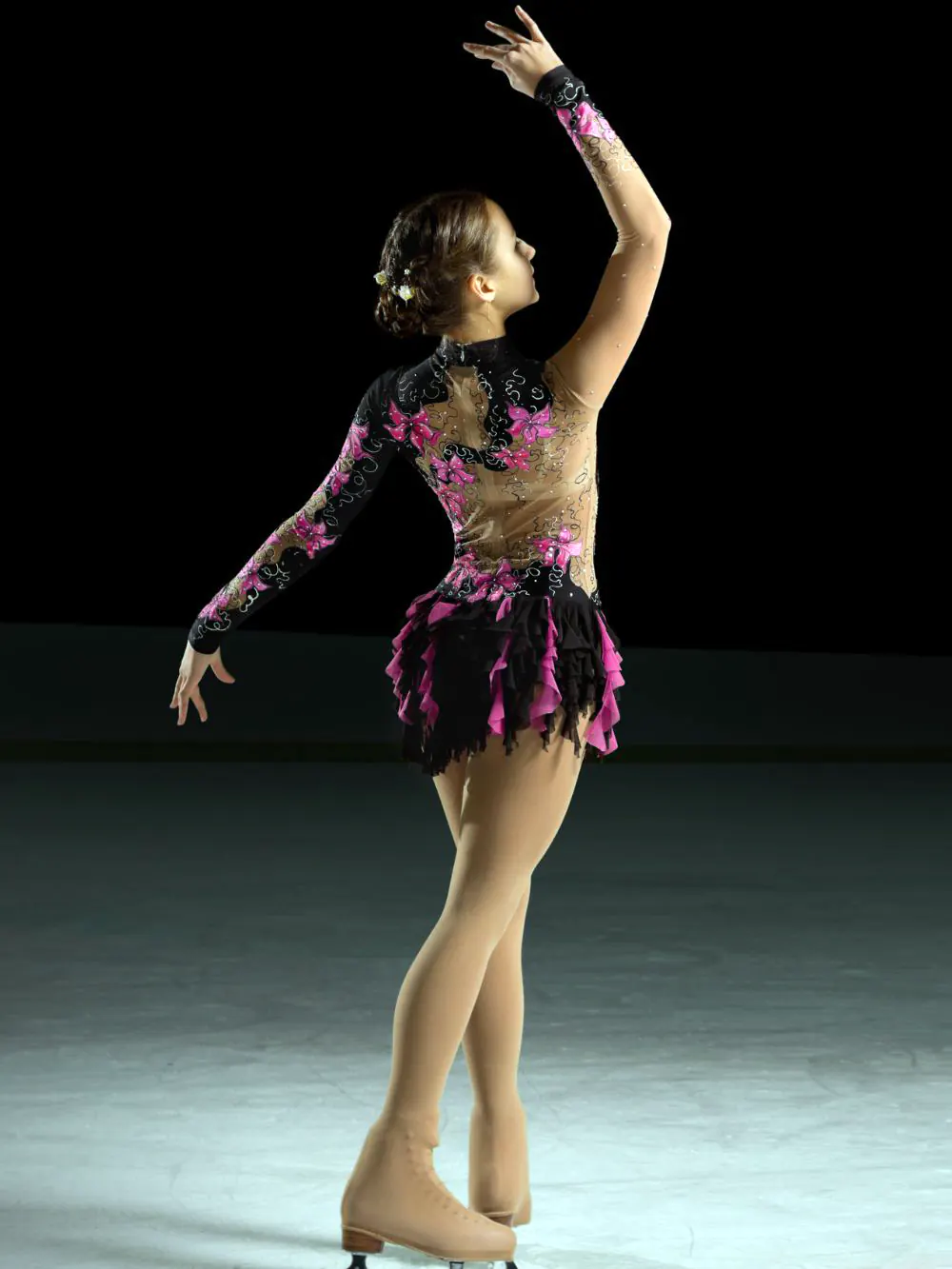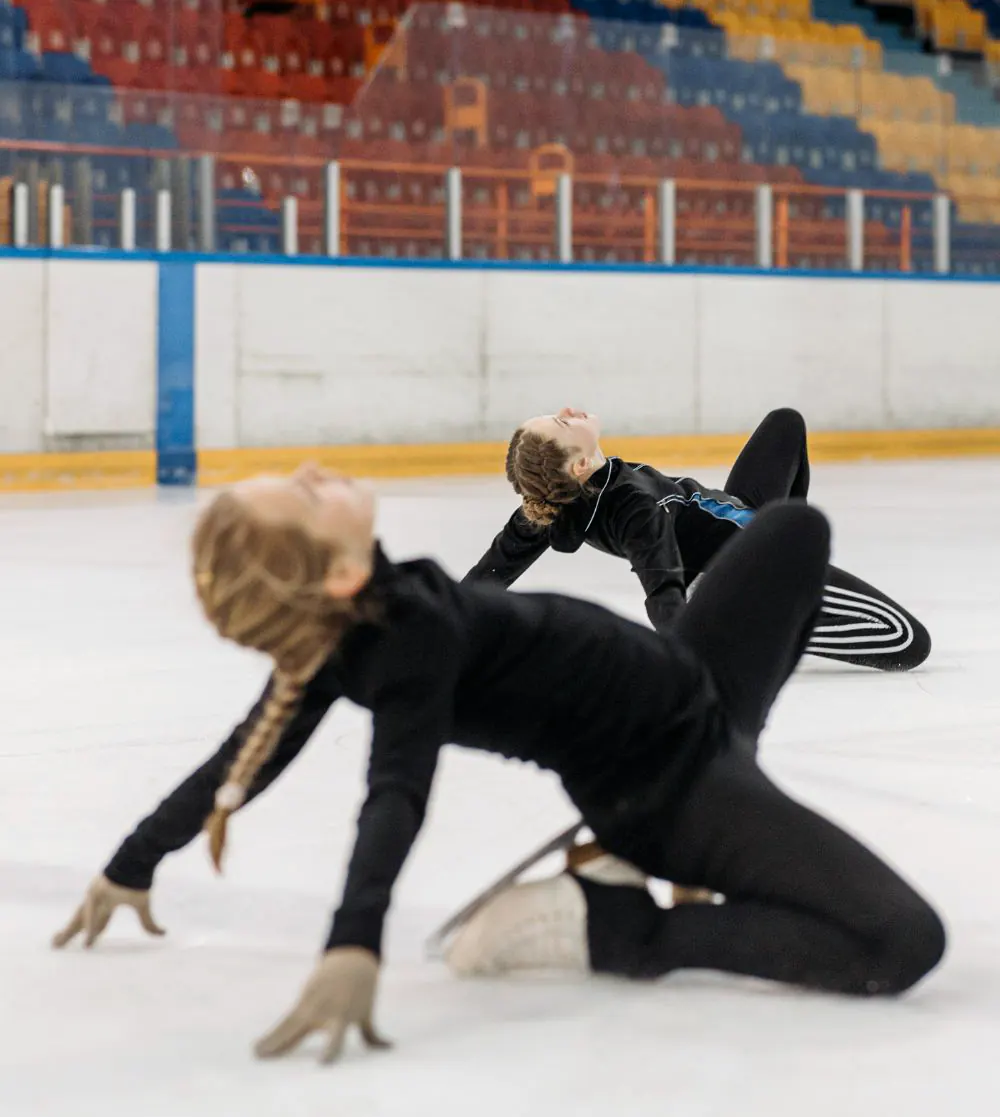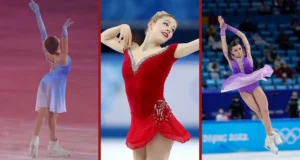A flash of colorful spandex outfits spinning across the ice rink, graceful figures executing precise jumps and technical spins – the world of figure skating delights audiences with its blend of artistry and athleticism. But what of those delicate white gloves covering the hands of so many skaters? Why do female figure skaters wear gloves – hiding those instruments needed for jumps, connecting with the ice, and expressing the music through movement?
The answer lies in both practical concerns and aesthetic preferences that reveal as much about the sport’s traditions as the skaters’ technical skills. From protecting fragile fingertips in punishing practices to completing a picture of choreographed elegance, gloves have become an essential yet often overlooked part of a female figure skater’s performance.
Why do female figure skaters wear gloves?
Gloves serve predominantly practical purposes for female figure skaters but also fit with the stylistic norms of the sport. They protect hands while allowing skaters to perform at their highest level. I hope this comprehensive list helps you better understand the facts.

To protect the skater’s hands from injuries
Gloves protect figure skaters’ hands during practices and performances. Skaters often fall during practice, so gloves protect their hands from the rough ice.
Gloves lessen the risk of cuts, scrapes, and bruises during falls. Skaters also grab and manipulate their sharp blades during spins and other moves. Gloves form a protective barrier between the skater’s hands and their blades.
The cold rink temperature also makes gloves useful for keeping skaters’ hands warm. Besides practical protection, gloves complement figure skaters’ costumes and add to their stylized presentation on the ice.
Overall, gloves mainly serve to shield skaters’ hands while allowing them to practice difficult moves without worrying about injuring themselves.
To hold warm air and shields the hands
Figure skating practice areas and rinks stay cold to smooth the ice. Gloves assist figure skaters by guarding their hands against this cold. The gloves trap warm air between the skater’s hands and the glove fabric. This helps keep figure skaters’ hands comfortable during long training sessions and performances.
Without gloves, figure skaters’ bare hands become exposed to frostbite risks from the low temperatures on the rink. Protecting their hands from cold takes on more importance the longer skaters practice or perform.
Gloves allow figure skaters to focus on perfecting jumps and tricks rather than worrying about their hands getting too cold. The warmth provided by gloves is essential for protecting figure skaters’ hands from frostbite dangers linked with extended time spent skating on ice in chilled rinks.
For extra grip for balancing
The gloves worn by figure skaters offer improved grip on the slippery ice surface. This extra grip helps figure skaters maintain balance and control while skating.
The grip assists skaters with executing difficult jumps, spins, and other moves that require a lot of balance and precision. The added traction from gloves helps skaters rotate faster and jump higher.
Some skaters prefer special fingerless gloves that provide traction but expose the fingertips. This exposes more bare skin to the ice and allows skaters to feel the ice with maximum sensitivity. The bare fingertips give skaters more dexterity for intricate moves that rely on skilled hand placement and ice contact.
Overall, the grip provided by figure skating gloves assists skaters in performing complex skills by giving them the traction and balance needed to pull off difficult spins and jumps with precision.
To complete figure skaters’ aesthetically-pleasing outfits
Gloves are an important part of the stylized aesthetic of many figure skating costumes. The fingers encased in fabric often coordinate with the colors and patterns of the female skater’s costume. The gloves become an extension of the outfit itself rather than just practical gear.
Some skaters wear decorative gloves that add visual flair to their costumes and performances. Jeweled or embroidered gloves complement the detailed, bedazzled costumes that figure skaters choose for competition.
Female skaters who seek an elegant and aesthetically-pleasing presentation see gloves as an opportunity to match their hands to the overall stylish picture created by the rest of their costume.
Coordinating gloves with their costumes allow figure skaters to convey a broader sense of unity and style in their pursuit of high-performance marks.
To enhance figure skaters’ precision on ice
The gloves figure skaters wear to create a thin layer between the skaters’ bare hands and the rough ice surface. This thin fabric layer slightly reduces friction between the skater’s hands and the ice. The reduced friction allows for more precise movements and placements of the hands and fingers on the ice.
Without gloves, a skater’s bare hands adhere more to the ice due to higher friction. This extra adhesion can unknowingly alter a skater’s hand positions and fingertips during jumps or spins.
However, when gloves create a small amount of friction reduction, figure skaters find their hand and arm movements become more exact and accurate. The lower friction helps their hands glide more smoothly into the correct positions needed for a perfect spiral or landing.
Many skaters report that this precision from reduced friction helps improve the overall quality of their performances.
Uses custom-made gloves for individual benefits
Many figure skaters opt for customized gloves tailored to their hands and skating needs. These gloves are designed and sewn to uniquely fit each skater’s hands’ proportions, contours, and dimensions.
Custom gloves provide the perfect balance of grip, flexibility, breathability, and protection for a skater’s individual jumps, spins, and other maneuvers. Off-the-rack gloves tend not to fit as comfortably or precisely as custom pairs.
Custom figure skating gloves are closely fitted to avoid excess material that could catch on blades or impede movement. The tailored fit of a custom glove enhances the feel and control on the ice while still cushioning the hand.
Customization allows skaters to get the perfect padding thickness, fingertips dexterity, and knuckles and wrists coverage.
Overall, custom-fitted gloves maximize performance for figure skaters by providing a unique fit that works perfectly with each skater’s individual technique.
Wears as a habit
For many figure skaters, wearing gloves becomes so ingrained in their daily training routines that they ultimately prefer to compete while still wearing them.
Since figure skaters practice far more than they perform, gloves become habitual for their time on the ice. When skaters have spent thousands of hours practicing jumps, spins, and stroking with gloves on their hands, performing without them can feel unnatural and uncomfortable.
Taking gloves off for competitions disrupts the accustomed movements and feelings that skaters associate with peak performances. The consistency of competing in the same gloves worn during practice helps maintain a skater’s confidence and mental focus.
For these skaters, the familiar feel of their habitual gloves during performances provides a sense of security and routine that enhances their ability to block out distractions and skate to the best of their ability.
To signify cultural traditions and excellence
Wearing gloves during figure skating performances has become culturally ingrained in certain regions. Russian and Japanese figure skaters most often wear gloves while competing.
This reflects longstanding traditions and aesthetic preferences within those countries. For decades, elite figure skaters from Russia and Japan have set the standards for technical prowess and elegant presentation within the sport. Their use of gloves while performing has thus become linked with high levels of artistry and skill.
Younger skaters in Russia and Japan consequently adopt gloved performances as they seek to emulate the styling and techniques of successful skaters from their regions. Over generations, gloved figure skating routines have become stylistically normalized in Russian and Japanese cultures.
As a result, many upcoming skaters from those countries now consider gloved performances simply traditional and customary within figure skating as showcased by their compatriots and role models.
What are the specific types of gloves that figure skaters wear?

Full Finger Gloves
Full-finger gloves protect figure skaters’ hands best. The gloves cover skaters’ whole fingers and hands. This covering fully protects fingers and hands from the ice. The gloves also improve grip, letting skaters spin and jump better.
Skaters wear full-finger gloves most during practice. Skaters often fall in practice. So full-finger gloves lessen the risk of cuts and bruises on hands from falling onto rough ice or grabbing sharp blades.
Fingerless Gloves
Fingerless gloves leave the figure skater’s fingertips open. The gloves only cover the back and palms of the hands. This exposes fingertips to touch ice direct. Skaters making complex moves need to feel ice exactly. So open fingertips give skaters more control and precision.
Though fingerless gloves offer less protection, they maximize tactile sensitivity. Many skaters wear fingerless gloves in competitions instead of full-finger gloves. Competing requires skaters to execute difficult jumps and spins precisely.
Close-Fit Gloves
Close-fit gloves match the figure skater’s hand shape exactly. Glove makers measure each skater’s hand size. Glove makers then sew gloves to fit snugly around the skater’s hand and fingers shape. This tailoring maximizes how well each glove works to suit each skater’s specific grips, moves, and needs.
Close fitting lets gloves protect best with the least extra fabric getting in how skaters move their hands. Too loose gloves risk catching blades or limiting the feel of ice. So custom-fit gloves enhance performance by optimizing individual skaters’ protection, grip, and sensitivity.
Frill Gloves
Frill gloves add fancy, decorative details to the figure skater’s hands. Makers add frills, sequins, beads, and patterns onto gloves. Skaters pick gloves and colors matching their costumes. Figure skaters wear frill gloves mainly for the look of performances. The gloves complete the look of a skater’s stylish outfit.
Though frill gloves offer little protection or feel of the ice, they complement costumes to match the theme of skaters’ routine or program. Frilly gloves impress judges by looking more at choreographed performances than technical aspects. So decorative gloves highlight beauty over practical use in figure skating.
Mesh Gloves
Mesh gloves allow most feel of ice surface direct. Glove fabric made from see-through, stretchy mesh lets air pass through. This keeps hands cooler and minimizes protection. The open weave fabric exposes almost all hands and fingertips touching ice. So mesh gloves maximize figure skaters’ tactile sensitivity.
Skaters feel ice every place their hands touch exactly. Pros prefer precision over padding and wear mesh gloves. Mesh gloves optimize sensing hand placement and finding ice contact points needed for perfecting difficult twists, turns, and jumps, requiring skaters to sense ice with the most sensitivity.
Summary
In the world of figure skating, the delicate white gloves worn by female skaters serve both practical and aesthetic purposes. Gloves protect the skaters’ hands from injuries during falls and provide warmth in cold rink temperatures. They also offer improved grip on the ice, enhancing balance and control during complex moves.
Additionally, gloves complete the aesthetically-pleasing outfits of figure skaters and contribute to their stylized presentation. Custom-made gloves are tailored to fit each skater’s hands perfectly, maximizing performance and comfort.
Wearing gloves has become a cultural tradition, particularly among Russian and Japanese figure skaters, who view it as a symbol of artistry and skill. Different types of gloves, such as full finger, fingerless, close-fit, frill, and mesh gloves, cater to various needs and preferences of figure skaters.
FAQ
What materials are gloves made of for figure skaters?
Some common materials used for figure skating gloves include spandex, lycra, microfiber, conductive fabric, silicone, and sanded poly spandex fabric. Some gloves also have protective gel in the wrist area to help reduce the risk of a wrist injury.
Do male figure skaters wear gloves too?
Yes, male figure skaters also wear gloves for many of the same reasons as female skaters.
What are specific brands of gloves that are popular among figure skaters?
Some popular brands include IceDress, Jerry’s Skating World, ChloeNoel, Bauer, EDEA, Elite Xpression, ES Performance, Eurotard, and Fabulous Furs. These brands offer a variety of gloves made from different materials and with different features, such as thermal gloves, grip gloves, and mittens.



